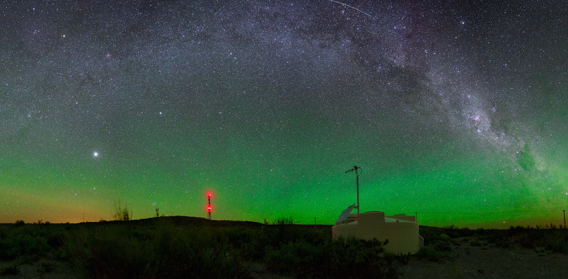The Pierre Auger Observatory is an international cosmic ray observatory in Argentina designed to detect ultra-high-energy cosmic rays: sub-atomic particles traveling nearly at the speed of light and each with energies beyond 1018 eV. In Earth's atmosphere such particles interact with air nuclei and produce various other particles. Secondary particles forming the so called "air shower" can be detected and measured in order to clarify the origin of the highest-energy primary particles and their properties like energy, arrival direction and the particle type (photons, protons, atomic nuclei). But since these high energy particles have an estimated arrival rate of just 1 per km2 per century, the Auger Observatory has created a detection area of 3000 km2 to be able to record significant number of these events. It is located in the western Mendoza Province, Argentina, near the Andes.
The Pierre Auger Observatory combines two complementary techniques to measure air showers. On their way through the atmosphere the secondary particles stimulate nitrogen molecules in the air to emit fluorescence light. This light is measured with large telescopes. In addition, secondary particles reaching ground level are registered in an array of particle detectors. The latter are water Cherenkov detectors, measuring the light emitted by relativistic particles passing through a water tank (Figure 6).

The Pierre Auger Collaboration had shown that the energy spectrum of cosmic rays exhibits a sharp drop around 1020 eV [14]. This drop is compatible with the Greisen-Zatsepin-Kuzmin (GZK) cut-off caused by the universe becoming opaque due to resonant collisions between ultra-high-energy protons and the photons of the cosmic microwave 2.7 K background radiation. Past measurements by the Pierre Auger Collaboration already have cast some doubt on this explanation, and this year’s results further established that the GZK cut-off cannot be the entire story and even the extent of its contribution to the cut-off remains unclear.
Collisions of ultra-high-energy cosmic rays on atmospheric molecules provide hadronic interactions at an energy that exceeds the LHC centre-of-mass energy by one to two orders of magnitude. Although progress was made in incorporating LHC results, some mysteries were not solved. The number of muons in Monte Carlo simulations is very significantly smaller than the number measured in experimental data. Also the depth at which most muons that reach the Earth’s surface are produced cannot be described by Monte Carlo simulation for any reasonable composition mix of cosmic rays.
The Pierre Auger observatory is currently upgrading its detection capabilities. The key element of the upgrade is the installation of a plastic scintillator on top of each existing surface detector stations. It will provide a complementary measurement of the showers allowing the reconstruction of muons and electromagnetic particles. The surface scintillator detector stations (SSD) are being deployed over the full 3,000-km2 area of the overall surface detector (SD). To enhance the capabilities of the surface detector, especially for composition measurements, it is being equipped with upgraded electronics with a larger sampling rate and a larger dynamic range.
[14] A. Aab et al. (The Pierre Auger Collaboration) , “ Features of the Energy Spectrum of Cosmic Rays above 2.5×1018 eV Using the Pierre Auger Observatory”, Phys. Rev. Lett. 125, 121106, (2020).